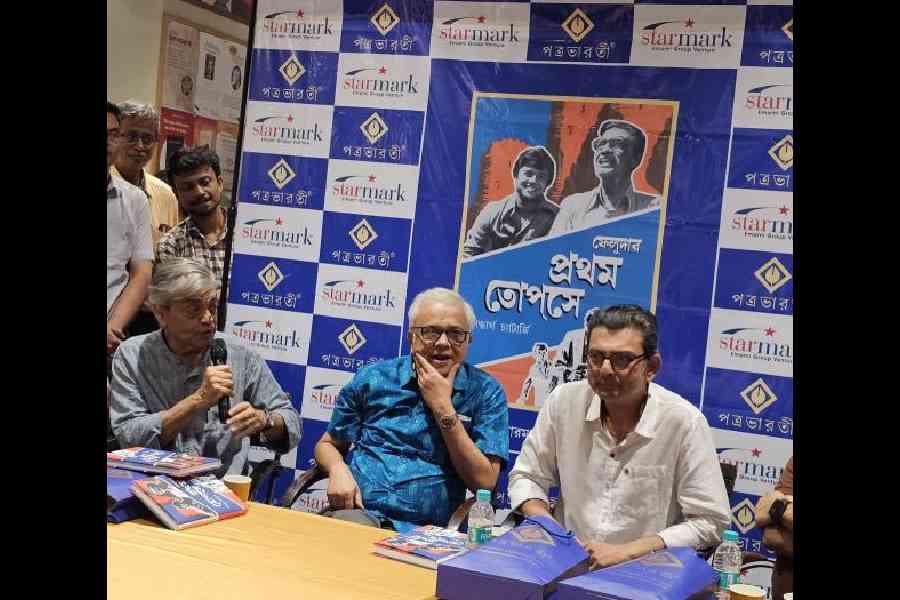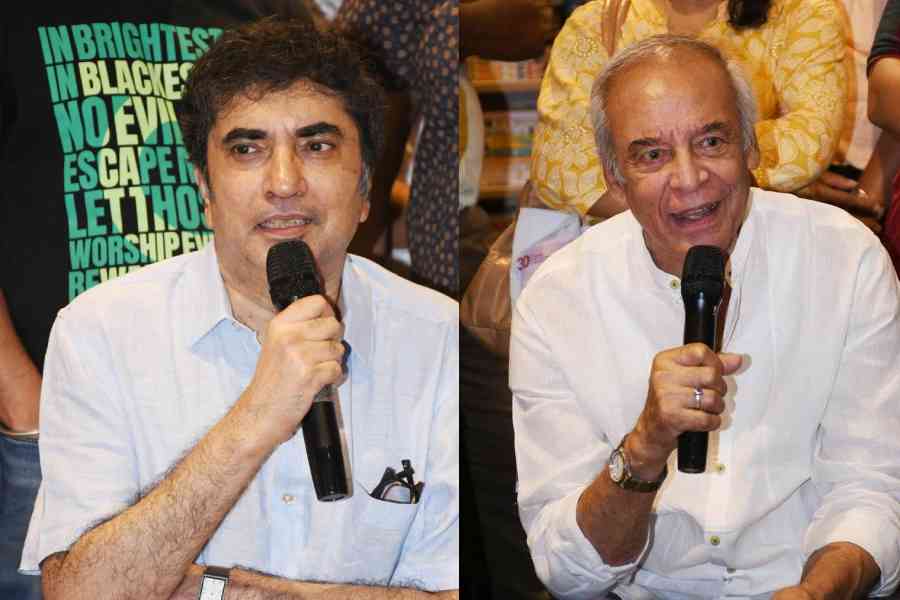In the preface to the book, Sandip Ray writes that to this day, Siddhartha Chatterjee’s number is saved in his wife’s mobile phone as Topshe Original. Sandip does not use a mobile phone himself. “Actually there are so many Siddharthas that it becomes difficult to understand (who is calling). So we prefer the original (identity),” he explains.
When Siddhartha Chatterjee decided to write his reminiscences of acting as the teenaged sidekick of Feluda (played by Soumitra Chatterjee) in Satyajit Ray’s detective films Sonar Kella and Joi Baba Felunath, the title could only be Feludar Prothom Topshe.
At the launch of the book at South City Mall, in course of a conversation compared by Tridib Chatterjee of Patra Bharati, Siddhartha explained why the title of his book could be no other. “I have done several films in the last 10 years. Yet you remember me only for a film done 50 years ago. That shows the pull of Sonar Kella. Even now if we spot a rerun on TV, we watch it from any point,” he said, turning towards Sandip. “Perhaps Babuda (Sandip’s nickname) can do another film where old Topshe can reprise the role,” he suggested.

Sandip Ray makes a point as Siddhartha Chatterjee and Kushal Chakraborty look on
Kushal Chakraborty, who played Mukul, too was awed by the film’s enduring “magic”. “Its dialogue, locations, acting, music — everything is immortal. Above all, it created the livelihood of the people of Jaisalmer. When I went there years later, every shop had pictures of Satyajit Ray on the wall. I do not think there is another instance in the history of films of the economy of a remote place being impacted in such a tremendous way by a single film,” Kushal said.
The casting
Little Kushal had no clue what a film was. But he knew about acting, having seen Nandikar plays that his father would take him to since he was two and a half. “I was asked to show my acting skills to Satyajit Ray. That might have convinced him that I could do the role.”
Also present at the launch was “nokol Mukul” Santanu Bagchi — the boy who was mistakenly kidnapped by the crooks initially. “I was very scared of our Bengali teacher at Patha Bhavan. One day after class, Parthada told me that he would come home the next day to meet my father. I thought I must have messed up big time and offered to settle the matter in school itself, bracing myself for all kinds of punishments. But he insisted on coming home. My father, on being told so, asked me to own up to whatever mischief I had committed. I was hard put to prove my innocence. Parthada had a closed-door talk with my father. When the door opened, my father simply asked me to accompany Parthada to someone’s house the next morning.”
Santanu still remembers the wooden steps and the high ceiling of the house. Ray opened the door himself and on spotting the boy, exclaimed in a tone of familiarity: “Oh, it’s you!”, much to the teacher’s surprise.
Little Santanu, after watching Goopi Gyne Bagha Byne, had met Ray earlier and told him that he knew the film and its dialogues by heart. “Manik Kaku had asked me to demonstrate that. I did a scene playing both roles by changing places. He enjoyed my effort with a hearty laugh and asked me if I would act in his film if he did one.
That day, he said: “The time has come. Are you ready?” Santanu recalled.
Sandip pointed out that Sonar Kella was made because of Kushal. “He was perfect for the role and was the first to be cast. Baba had already shown Jaisalmer fort in Goopi Gyne Bagha Byne. The Halla king’s fort is sonar kella. He had wanted to make Goopi Bagha in colour but that did not happen. That worked out for the best as otherwise there would not have been the surprise element in colour at the end of the film.”

Anik Dutta, Barun Chanda
Yet he liked Jaisalmer so much that he wrote the script of Sonar Kella. He also got the confidence to shoot Feluda in colour. The last actor to be cast was Feluda. Ray, recalled Sandip, was in a quandary. “When we asked him for a description so that others could look around as well, he said Felu would be ‘a bit like Soumitra, a bit like Subhendu, a bit like Dhritiman, a bit like Barun Chanda.... I told him he would never find anyone like that and advised him to think afresh. Finally, the role was Soumitra Kaku’s to shoulder.”
Soumitra, he revealed, was sceptical about reading the Sonar Kella script. “He told Baba: ‘Ami ki korbo? Amar toh bisesh kichhu korar achhe bole mone hoy na.’ Baba told him: ‘You just follow the script,’” said Sandip.
Moloy Roy’s presence added a muscular touch to the launch, belying his 77 years. Soumitra used to train under his father, Mr Universe Manotosh Roy. “Satyajit Ray must have told him that he needed a young body-builder for his new film Joi Baba Felunath. I had taken part in Mr Asia by then. So he asked my father if I was interested.”
Moloy came on board despite his protestations of knowing nothing of acting. He was given a small script and asked to practise his lines. But what he had not practised was lifting people. “I was supposed to lift Santosh Dutta (who played Jatayu) but he was wriggling so much that I dropped him twice. I even sprained a finger in the process. Soumitrada asked me to go and practise lifting those who were working on the sets. ‘Weight tola ar manush tolay farak achhey. You figure out where you can get a good grip on a human figure,’ he told me.”
Ray & his child actors
Kushal busted a myth propagated by tourist guides who take Bengali tourists to see “Mukuler bari” in Jaisalmer fort. “Mukul’s house was built in Indrapuri Studio floor no. 4 by art director Ashok Bose,” he clarified.
Every child in Ray’s films, be it Apu-Durga in Pather Panchali or Ratan in The Postmaster, he pointed out, has put on a brilliant act in front of the camera. “But none of them has written a book on the experience. Siddharthada is the first to do so. This will remain as a valuable document,” pointed out Kushal, whose father Rudra Chatterjee had also penned a book called Sonar Kellar Sandhane.
Young Santanu, Sandip said, had a scene with a long monologue (describing the kidnapping). “Baba had kept some cut-aways in the story board, like Feluda’s reaction, which would be included in case Santanu failed to deliver the lines at one go. But he did so in one shot and in one take,” he said, as the audience applauded.
The precocious child that he was, Santanu had asked him afterwards: “Jethu amake eto khoka khoka dialogue diyechhe kyano bolo toh? (Can you tell me why uncle gave me such child-like lines?),” Sandip said.
Kushal shared how Ray would treat his child actors with dignity. The unit was returning to Jodhpur after shooting in Bikaner. The winter sky of Rajasthan was punctuated with stars. Over a distance of 250km, little Kushal kept asking questions on the constellations. “Everyone was tired after the day’s shoot. Bijoya Ray, and then Soumitra Kaku, gave up. My father was embarrassed but could do little to stop me except glare. Sensing that, Manik Kaku came to my defence —‘Na na, o toh chhoto. O toh proshno korbei' — and took over. Despite having toiled the most, he continued a conversation on the cosmos through the journey, such was the depth of his knowledge. This is why children trusted him. That reflected in their performance.”
On the sets, young Kushal was closest to Siddhartha, the second youngest, and Sandip, who was a year older to Siddhartha. “The only adult with whom I had interactions was Kamu Mukherjee. He had a selfish motive as he loved to eat. Kamu Kaku was a very energetic man — he would be doing production work, minding the crowd, holding ropes to control onlookers… He would eat one of the two boiled eggs that were allocated to me, saying I was too young to have both.”
There was another item that Mukherjee took a share of. “It was bitterly cold in Rajasthan when we were shooting. Jethima used to dab cream on my face every night to prevent dry skin and cracked lips. I hated it. To bribe me into letting the cream be applied, a packet of toffees would be gifted to me every day. Kamu Kaku would claim a share from that as well.”
Siddhartha as Topshe
From the audience, filmmaker Anik Dutta, who was a year junior to Siddhartha in Patha Bhavan, reminded him that during the audition he had told Ray that he had not read Feluda. Chatterjee responded: “Yes, I said I liked Byomkesh and that my favourite was (the pulp thrillers of) Swapan Kumar. Our teacher Parthada had hastily left for the loo in embarrassment.”
Barun Chanda, the protagonist in Ray’s Seemabaddha who has penned his own memoir Satyajit Katha, shared his first impression of Feluda’s first Topshe. “There was always an innate smartness in you. Sometimes you exuded a bit of a smart Alec, which Soumitrada managed to drag down a notch when you went overboard. You two formed a great team,” Chanda told Siddhartha.
